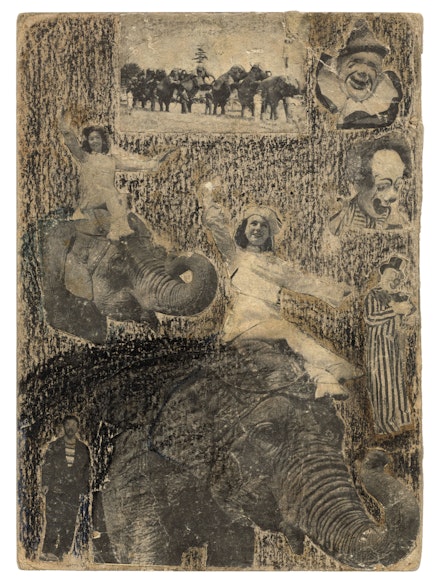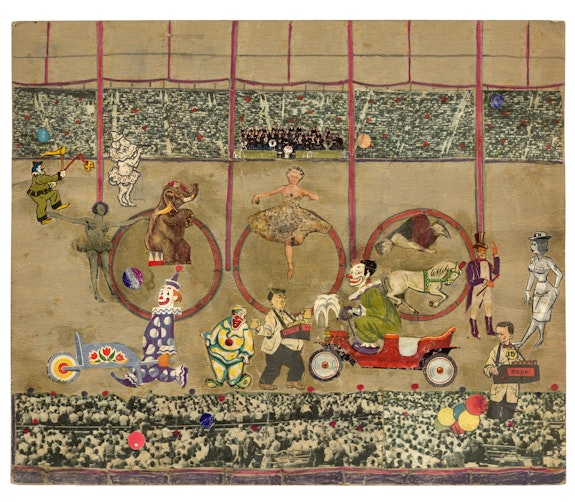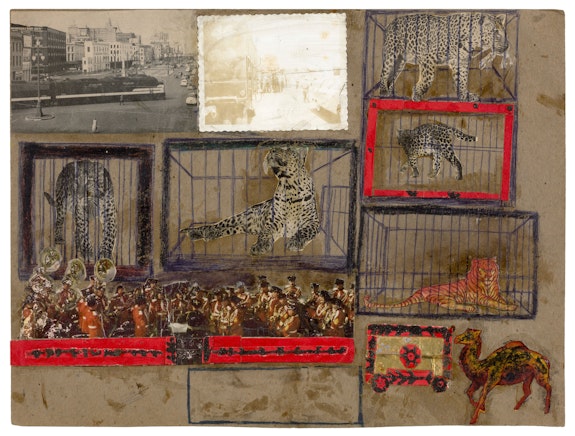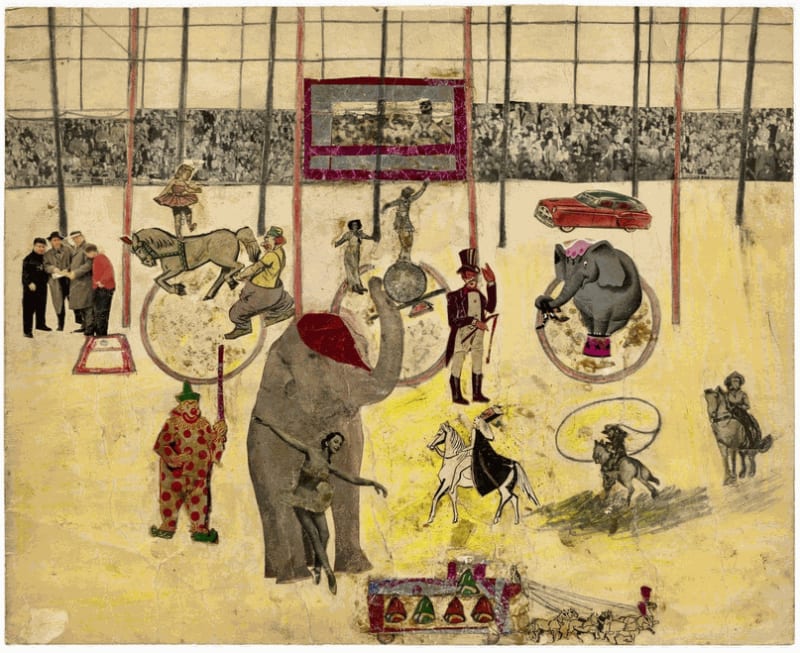The collaged works in C.T. McClusky: Circus Surreal are installed in an orbit around a suitcase that sits on a pedestal at the entrance of the gallery. Bathed in a warm yellow spotlight, with edges warn away, it greets visitors with the word “circus” affixed in large letters peeling from its surface. This suitcase is presented as a surrogate for the artist, of whom little is known, beyond the unverified claim that he was a traveling circus clown. It also functions as a stripped down reenactment of the collection’s origin story, allowing viewers to experience something of the moment when curator John Turner discovered this case full of artworks in 1975 at the Penny Flea Market Island Drive in Alameda, California, where it was placed for sale by the daughter of McClusky’s sometimes landlady.

The works themselves are not particularly large, as one might assume from their suitcase home. They include both hand-drawn and collaged elements, with the printed materials used dating the creation of the works to sometime between the late 1940s and the mid-1950s. The time period coincides with the conclusion of the golden era of traditional American circuses, with 1956 marking the final year that the combined Ringling Brothers and Barnum & Bailey circus was performed under a canvas tent. McClusky’s imagery is rich in a multitude of Americana icons lifted from the pages of magazines, newspapers, photographs, comics, and other ephemera, including metallic candy wrappers, animal cracker boxes, and cigarette packs. These collaged elements collide together in interesting ways, skewing a sense of size and perspective as performing clowns, trapeze artists, ballerinas, and musicians churn in constant motion across the page, their variable size in relation to one another upending any sense of a particular depth within the picture field. Animals are littered across the works, clustered together in loose arrays of dogs, horses, elephants, and exotic cats that fill performance stages, pack together in the compartments of boxcar trains, and linger around the periphery of tents. There is also a proliferation of transportation: airplanes, converging train tracks, a multitude of cars and trucks that scatter in all directions. This gives the works a transient quality, a sense of grand spectacle from which the audience and performers alike will soon depart.
Importantly, the works incorporate drawings to contextualize and embellish the collaged elements. The consistent hand renderings are primarily architectural and center around the big top itself in various states of erection and deconstruction. It becomes an abstracted rectangular grid that is both specific in its riggings and features, but also amorphous in its grounding and floating perspective. The three ring center stage is repeated in various states of realism until it is simply placed in the center of some works as three bold colored circles, filled with animals and entertainers or sometimes empty, acting as flat symbolic disks. Combined with the collaged images, the effect creates a dream circus clipped from the public imagination and arranged with waxy crayon drawings and pencil lines.

Writing in the exhibition catalog, Alejandra Russi offers that, “McClusky appropriated and repurposed pieces of this graphic excess into his mental geography—materializing again and again in his collages—and in doing so he found a formal and spiritual outlet that paralleled Surrealism’s best efforts to free the unconscious mind from creative restraints.” In another way, the artist himself is a surrealist form, that of an exquisite corpse. Despite his best efforts, the curator who originally purchased the work was unable to track down or confirm any evidence of McClusky’s life or work. The artist remains an absent body, built in parts from a chain of narrators, from his seasonal landlord, to the flea market vendor, to the original curator, and on to its reimaging in the gallery today.

There is a hazard, when presenting work made by what are generally called “outsider artists,” of letting the biography (or outsider status) of the artist overshadow the work. This impulse is further complicated with an artist such as McClusky, for whom so little is known. In this exhibition, the unsatisfiable urge to provide details of the artist’s life and practice has led the gallery to partially fill that void with a somewhat awkward video compilation of found footage featuring circuses from the era McClusky is thought to have worked in, presented alongside the paintings without didactic material. The inclusion works against the basic truth of the exhibition: that the artist called C.T. McClusky is made up of exactly two things: a story told by John Turner and a small, battered suitcase full of 53 artworks. Despite the dearth of personal material, a scan of the gallery guide revealed that a good number of the works had already been sold. A notable exception to that trend was the circus suitcase itself, which was explicitly listed as not for sale.

